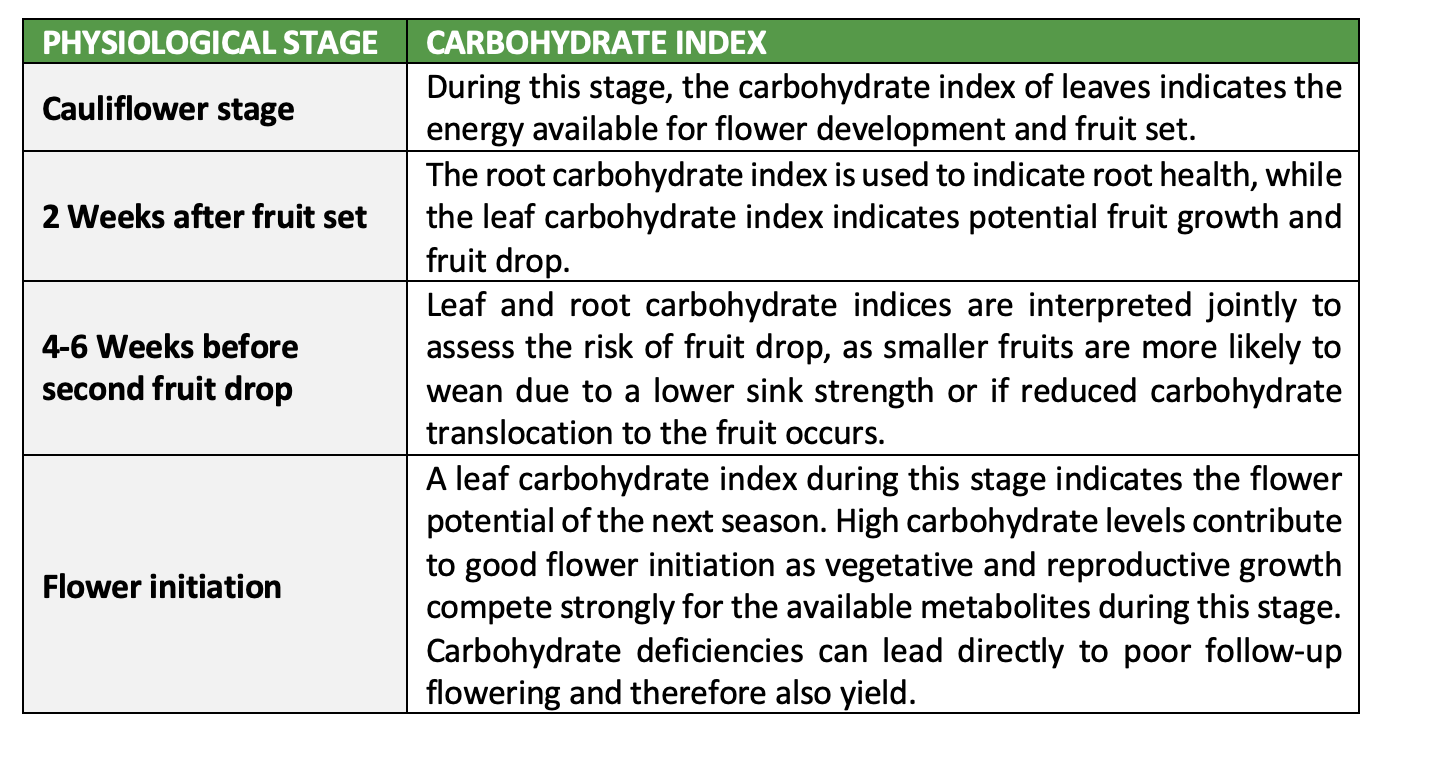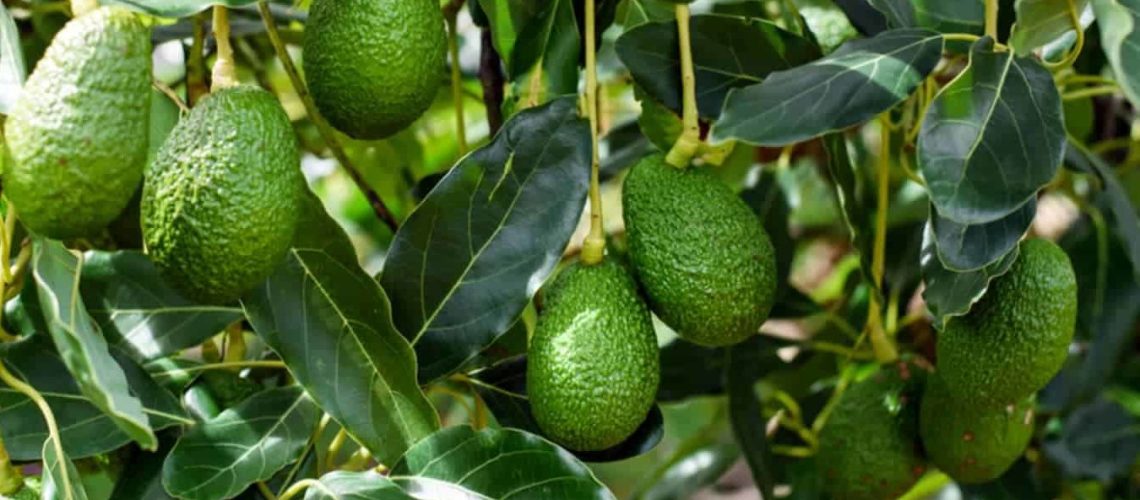How your avocado orchard benefits from carbohydrate analyses – By Dr Elmi Lötze (Head of ITEST™CARBOHYDRATES and ITEST™LEAF) and Wilmé Brown (Plant Physiologist), Agri Technovation
Carbohydrates as physiological indicator of plant status
The use of carbohydrate analyses to study plant performance is an established practice in the research environment (Wolstenholm, 1987; Whiley et al., 1988; Davie et al., 1995). The selection of tissues/organs most appropriate for carbohydrate information, the dynamics of the sugar:starch ratio during the season, as well as its impact on plant physiology and management practices, have been the research topic of many a published article. Agri Technovation’s ITEST™CARBOHYDRATES service, takes what science has established so far and applies it as solutions at farm level. With this service, existing information is integrated for the purpose of adapting management practices at orchard level, the results thereof are quantified in terms of a carbohydrate index (CI) and the future expectation for specific crops is indicated, using a physiological indicator (the CI).
Proven relationships between carbohydrate status and plant performance
Wolstenholme (1987) and Whiley et al. (1988) have already shown that a low carbohydrate status in the avocado plant is directly responsible for poor fruit set, slow early fruit growth and fruit drop. In avocados, carbohydrates are produced mainly in the leaves and during spring, and then, from approximately 25 days after bud break, the new leaves begin to contribute to the plant’s carbohydrate reserves (Lui et al., 1999). Prior thereto, the growth of new leaves depends on the carbohydrate reserves in older leaves, shoots, the stem and roots.
Photosynthesis
Photosynthesis, thus the manufacturing and availability of carbohydrates for plant performance, is determined by several factors. In the discussion below the focus is mainly on two factors: climate and cultivar. The seasonal carbohydrate trend in a plant organ follows a fairly standard pattern, but individual values vary between cultivars, climatic zones, crop loads and others. A common trend, that of low mid-summer and high late-winter carbohydrates, was observed in the cool, dry interior of south-eastern Australia and was linked to alternate bearing. High carbohydrate levels in storage organs (for example the stem, shoots and roots) resulted in a so-called on-year, while low levels resulted in an off-year. This observation stirred the interest in the development of a carbohydrate index that could be used to predict crop load. Good results were achieved with predictions for the Hass and Fuerte cultivars in cooler regions, typically with a Mediterranean climate. These results will also apply to other avocado types. However, predictions were less accurate in warmer areas, which highlighted the impact of additional factors such as flower formation and the role of nutrition and healthy root development on predictions. As first example, the Hass crop load was found to be related to stem- and shoot starches during flowering. Subsequent to this, mention was also made of the so-called Whiley Pheno-Physiological model, but these models were not developed any further.
For carbohydrate production in the subtropics (more humid conditions and cloudy days), focus is rather placed on optimising photosynthesis of the current leaf canopy, as well as optimal management of light distribution inside the trees. The Fuerte cultivar, as second example, is less dependent on carbohydrate reserves for maintaining a crop load than the Hass, but more dependent on the current season’s leaf carbohydrates in the subtropics (Schölefeld et al., 1985). For this reason, it is important that carbohydrate results of avocado varieties should always be interpreted within the appropriate context and that note should be taken of genetic differences in certain circumstances, even if the information applies to all varieties. The presence of healthy, active foliage is therefor of utmost importance in both examples above, and in this instance mineral plant nutrition, pest and plague control, irrigation and the management of light inside the tree all play a critical role.
Rootstocks
The rootstock of avocados also plays a major role in carbohydrate build-up in the respective plant organs (Whiley et al., 1996). The carbohydrate index may therefore differ for different cultivars under similar cultivation practices, due to different rootstocks.
Carbohydrates and fruit growth
There is also a close relationship between carbohydrates and flower bud initiation, fruit set, fruit drop and fruit quality (Davie et al., 1995; Van Vuuren et al., 1997). Low carbohydrate reserves during fruit set and development will result in increased fruit drop. (Davie et al., 1995). Low carbohydrate reserves after harvest lead to low flower initiation as well as poor flowering and fruit set the following year. Typically, these challenges can be addressed with management practices before the start of the following season, provided that the carbohydrate status of the tree/organ is available. In avocado trees, especially during the first 42 days after bud break, there is strong competition between vegetative and reproductive growth as these organs compete for the available carbohydrates in the plant. A good carbohydrate status under normal conditions will significantly reduce fruit drop.
Management practices for avocado trees with low carbohydrate status
Management actions affect the carbohydrate status of the tree and several practices can be applied in order to respond timeously to inadequate carbohydrate levels.
Mineral nutrients
Firstly, the nutritional status of the leaves is determined as it has a direct and/or indirect influence on photosynthesis and the translocation of sugars in the tree. Relationships between the mineral elements responsible for the transportation of sugars and the tree’s carbohydrate (sugar) status are determined in order to indicate the deficiencies, which are then corrected with targeted leaf sprays. The leaves should also be monitored visually throughout to make sure that sufficient healthy leaves are present for optimal production of sugar during photosynthesis. If the manufacture and/or distribution of sugar in a plant (i.e. low carbohydrate status) is not caused by mineral nutrient deficiencies, other management practices may be applied to address the low carbohydrate status.
Girdling
Although this practice is not common in avocados, it can be used to cut off or interrupt the translocation of carbohydrates to the roots at a specific time, which will result in an increase in carbohydrate levels above the girdling wound. Girdling can therefore be used to ensure adequate sugar and starch levels during an energy intensive period such as flowering, in order to increase fruit set.
ITEST™CARBOHYDRATES also determines the carbohydrate levels in plant roots, where low levels may indicate increased susceptibility to secondary infections. Root infections deplete the carbohydrate reserves in the tree’s tree roots and, if this depletion overlaps with a high crop load, it could cause the trees to die back and weaken. Trees with low carbohydrate levels in the roots should therefore not be considered for girdling as it will lower the carbohydrate status of the roots even further, which will ultimately harm above-ground growth.
Extended hanging time and crop planning
Avocados can remain hanging on the tree for some time after reaching physiological ripeness. This advantage is readily utilised by producers for purposes of marketing and to create a need in the market. However, these fruit still use carbohydrates from surrounding tissues as cell division and respiration (fruit growth) continue. The additional time on the tree therefore usually causes a low carbohydrate status in the tree and could result in alternate bearing the following season. To prevent this risk, a carbohydrate sample could be taken and analysed prior, which will indicate the blocks where the sugar:starch levels are already lower. Preferably, avocado fruit in these blocks should not hang for an extended time and the blocks should be harvested first, so as to timeously counteract the drastic alternate bearing pattern. Carbohydrate analyses of ‘late hanging blocks’ could also indicate to what extent corrections are required and/or how successful corrections have been to address the carbohydrate status of the tree.
Sampling for carbohydrate indices

Carbohydrate samples are taken during specific physiological stages (critical action times) during the season to indicate the need timeously and to be able to make the necessary corrections. The respective stages and corresponding use of the CI are set out below.

Conclusion
Carbohydrate analyses therefore provide several benefits to the producer. Analyses during all of the above stages firstly provide a historical-physiological perspective on environmental conditions and orchard practices up to and including sampling. In addition, the analysis data can be leveraged to plan timely management actions in order to address a low carbohydrate status in time. Finally, the carbohydrate index in certain crops can be used to predict crop loads.
With all these benefits packaged into one tool, ITEST™CARBOHYDRATES analyses should definitely form part of a producer’s decision-making.
References:
- Liu, X., Hofshi, R. and Arpaia, M.L., 1999. ‘Hass’ avocado leaf growth, abscission, carbon production and fruit set. In: M. L. Arpaia and R. Hofshi (eds.), Proceedings of Avocado Brainstorming. Session 3. Canopy Management. Pages 52-55. October 27-28, 1999. Riverside, CA. Hofshi Foundation.http://www.avocadosource.com.
- Scholefield, P. B., Sedgley, M. and Alexander, D. McE., 1985. Carbohydrate cycling in relation to shoot growth, floral initiation and development and yield in the avocado. Scientia Hort, 25, 99 – 100.
- Whiley, A.W., Saranah, J.B. and Rasmussen, T.S., 1996. The relationship between carbohydrate levels and productivity in the avocado and impact of management practices, particularly time of harvest. HAL final report.
- Wolstenholme, B.N. 1987. Root: shoot: fruit interactions as factors affecting recovery of avocado trees treated with phosphorous acid. In: The Phosphorous Acid Story. Queensland D.P.I. RON 87001, pp. 12 – 2.
- Whiley, A.W., Saranah, J. B., Cull, B.W. and Pegg, K. G., 1988. Manage avocado tree growth cycles for productivity gains. Queensland Agric J, 114, 29 – 36.
- Davie, S.J. van der Walt, M. and Stassen, P.J.C., 1995. A study of avocado tree carbohydrate cycles to determine ways of modifying alternate bearing. proceedings of The World Avocado Congress III, 1995 80-83.
- Janse van Vuuren, B. P. H., Stassen, P.J.C. and Davie, S.J., 1997. South African Avocado Growers’ Association Yearbook 1997. 20:59-62 Sink Demand for Starch Reserves in Avocado Trees.

